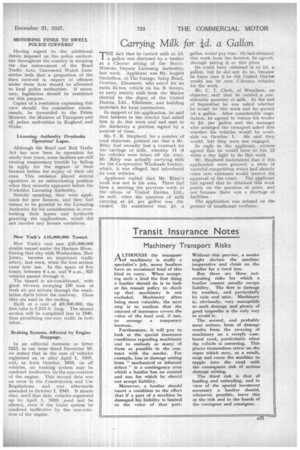Transit insurance Notes
Page 5

If you've noticed an error in this article please click here to report it so we can fix it.
Machinery Transport Risks
A LTHOUGH the transport .11.of machinery is really a specialist's job, many hauliers have an occasional load of this kind to carry. When accepting such a load the first thing a haulier should do is to look at his transit policy to check up that machinery is not excluded. Machinery often being most valuable, the next step is to confirm that the amount of insurance covers the value of the load and, if not, to arrange a temporary increase.
Furthermore, it will pay to look at the special insurance conditions regarding machinery and to embody as many of them as possible in the contract with the sender. For example, loss or damage arising from " mechanical or inherent defect " is a contingency over which a haulier has no control and one for which he should not accept liability, Moreover, a haulier should insert a condition to the effect that if a part of a machine be damaged his liability is limited to the value of that part.
Without this proviso, a sender might declare the machine inoperative and claim on the haulier for a total loss.
But there are -three outstanding risks for which a haulier cannot usually escape liability. The first is damage by weather, and particularly by rain and mist. Machinery is, obviously, very susceptible to such damage and plenty of good tarpaulin is the only way to avoid it.
The second, and probably most serious, form of damage results from the swaying of machinery on a steeply cambered road, particularly when the vehicle is cornering. This places tremendous stress on the ropes which may, as a result, snap and cause the machine to topple into the road with the consequent risk of serious damage arising.
The third risk is that of loading and unloading, and in view of the special treatment necessary a haulier should, whenever possible, leave this at the risk and in the hands of the consignor and consignee.
































